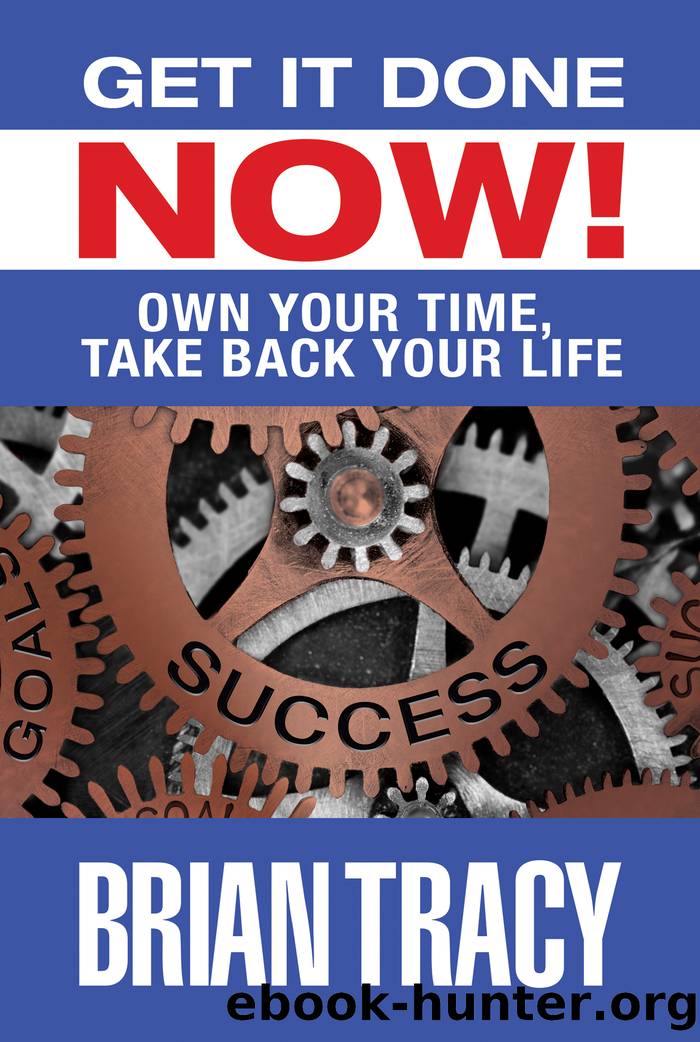Get it Done Now! by Brian Tracy

Author:Brian Tracy
Language: eng
Format: epub
Publisher: G&D Media
Published: 2020-06-14T16:00:00+00:00
The Art and Science of Meetings
With meetings, the first rule of law is, again, preparation. Make a list of everything you want to cover in the meeting.
The second rule is to circulate an agenda to everybody who’s going to attend outlining the subjects you’re going to discuss.
The third rule is to tell each person what they will be expecting to contribute: “We want you to be able to speak intelligently or answer questions on this subject.”
Hold the meeting at a specific time—both a specific starting time and a specific ending time: the meeting is going to be at 10:00, and it will end at 10:50 sharp.
At 10:00, lock the door. One of the most challenging things in the world of work is excusitis. People come into the meeting late, so they miss the first five or ten minutes, when the most important subjects are laid out. Then you have to stop the whole meeting.
I learned this from a man who started off selling used cars and became the second-richest man in Canada. When he started a sales meeting, he locked the door. If you weren’t there, you had to wait outside, and you’d better be there early next time. Nobody was ever late twice.
So lock the door, and don’t let latecomers in. Assume that they are not coming at all. Never wait for latecomers; that’s another big time waster. You say, “I’m sure so-and-so will be here soon. He’s on the phone.” Assume the latecomer is not coming at all, and begin immediately on time.
Start with the most important items first, so if you run out of time, it’s on the least important items. In a staff meeting, for example, I go around to each person and have each one make a contribution. “Please tell us what you are doing. How is it going? What are your plans for the immediate future, and what help can we give you to be more effective?” We go from person to person. Some people have a lot to contribute; some have little. When I started calling on people who’d never been called on before, within two or three weeks, they came prepared; they contributed, and they asked questions.
The next stage was to revolve the chairmanship at the meeting: “Here’s the meeting: it’s all planned and laid out, and Camille or Bill is going to chair it today.” At first, when I told them they were going to be running the meeting, people were very nervous, but then what did they do? They prepared. When they came, they were ready. They handed out the minutes and the agendas, and they made sure that they had information. They were amazingly responsible.
Meetings are one of the most wonderful tools for staff development. You can help to make your staff better and better by engaging them in contribution, asking for their opinions, putting them in charge of meetings, and giving them responsibilities for follow-up.
Then, five or ten minutes or five minutes before the meeting ends, say, “We’re going to be wrapping up now.
Download
This site does not store any files on its server. We only index and link to content provided by other sites. Please contact the content providers to delete copyright contents if any and email us, we'll remove relevant links or contents immediately.
| Bookkeeping | Business Mathematics |
| Business Writing | Communications |
| Decision Making | Negotiating |
| Project Management | Running Meetings & Presentations |
| Secretarial Aids & Training | Time Management |
| Training |
Nudge - Improving Decisions about Health, Wealth, and Happiness by Thaler Sunstein(6641)
Deep Work by Cal Newport(5492)
Principles: Life and Work by Ray Dalio(5330)
The Doodle Revolution by Sunni Brown(4048)
Factfulness: Ten Reasons We're Wrong About the World – and Why Things Are Better Than You Think by Hans Rosling(4029)
Thinking in Bets by Annie Duke(3540)
Eat That Frog! by Brian Tracy(3523)
Writing Your Dissertation in Fifteen Minutes a Day by Joan Bolker(3301)
Visual Intelligence by Amy E. Herman(3284)
Hyperfocus by Chris Bailey(3278)
How to Win Friends and Influence People in the Digital Age by Dale Carnegie & Associates(2830)
How to win friends and influence people by Dale Carnegie(2830)
Schaum's Quick Guide to Writing Great Short Stories by Margaret Lucke(2807)
Hidden Persuasion: 33 psychological influence techniques in advertising by Marc Andrews & Matthijs van Leeuwen & Rick van Baaren(2787)
The Pixar Touch by David A. Price(2744)
Ogilvy on Advertising by David Ogilvy(2691)
The Slow Fix: Solve Problems, Work Smarter, and Live Better In a World Addicted to Speed by Carl Honore(2578)
Work Clean by Dan Charnas(2563)
The Content Trap by Bharat Anand(2495)
